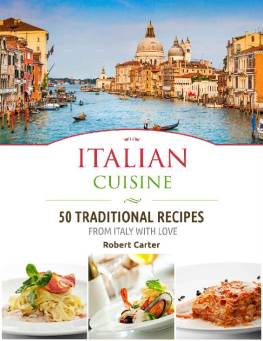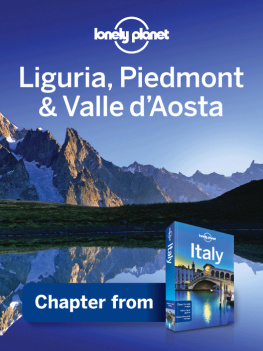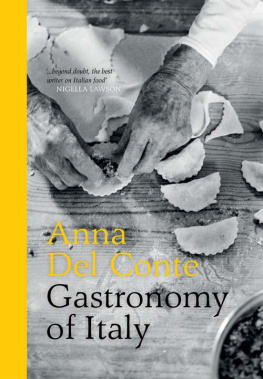A Land of Riches
The wide selection of fine produce found in northwestern Italy translates into some of the tastiest dishes in Italian cuisine
F rom remote mountain villages and sprawling vineyards to some of the world's most sophisticated cities, the northwest of ItalyPiedmont (Piemonte), Lombardy (Lombardia), and Valle d'Aostaoffers a great study in contrasts. And it is not only the landscapes that are varied, but this area also boasts both sophisticated city-styled culinary traditions and rustic farmhouse cooking. As in all of Italy, climate and agriculture create each region's culinary destiny here; the inhabitants of these three provinces and their subdivisions eat fine, locally grown produce.
Thanks to the Po RiverItaly's largestthere is no problem growing produce in abundance in the northwest. The Po River originates in northwest Italy, at Mount Monviso in the Cottian Alps, and runs through Turin and then eastward along the southern border of Lombardy until it empties into the Adriatic. Not only does the Po effectively cut off this region from the rest of the country; it also creates some of the most fertile farmland in Italy. The river's valley is an ideal growing environment, and the river itself and its tributaries supply abundant water.
This part of the country is dairy territory. In the countryside, cows and goats provide milk, much of which is used to produce the outstanding cheeses for which northwestern Italy is famous. Milk appears as an ingredient in soups and rice dishes in all three of these regions, and anyone convinced that the "Mediterranean diet" relies only on olive oil will be shocked to see the copious amounts of butter used in most dishes here.

Rice has been grown in the Po Valley since the 15th century.
Likewise, anyone convinced that Italians eat pasta every day will be surprised to see the range of inventive primi, or first courses, served in this northwest corner of the country. Fresh egg pasta is common, but more often northwestern Italians begin a meal with a soup, rice-based dish, or polenta.
The Piedmont diet in particular relies heavily on rice. Rice has grown in the flood plain of the Po Valley since 1475. Most likely it was imported from Spain, where it had been introduced by the Arabs. Today the Piedmont town of Vercelli is the location of the national rice market. The rice grown in this area is medium-to short-grain rice, such as arborio, vialone nano, and carnaroli, and all three of these have a special starchy coating. This coating is released during the cooking of risotto to provide the dish's most marked characteristicits creamy and soupy consistency.

Piedmont is a large producer of cheese, the most famous types being bra, tome, tomini, castelmagno, acceglio, and bross.
The people of Piedmont and Lombardy have a reputation in Italy for working hard and for living lavishly. Lombardy is home to Italy's famous fashion houses, while Piedmont is historically linked with a house of a different type: the House of Savoy, Italy's former royal family, which after 1861 ruled almost all of what is today modern Italy.
Both Lombardy and Piedmont have as their centerpieces bustling and large (at least by Italian standards) cities: Turin in Piedmont and Milan in Lombardy. Each of these is in turn surrounded by charming smaller cities, such as Asti, Alba, and Vercelli in Piedmont, and Cremona, Pavia, and Mantua in Lombardy.
Valle d'Aosta is a bit of an outsider among this cosmopolitan group. It is Italy's smallest and least populous region with 115,000 inhabitants. Although sparsely inhabited, Valle d'Aosta is home to several mountainsMont Blanc, Mount Rosa, the Matterhorn, and the Gran Paradiso (which at 13,324 feet is the centerpiece of Italy's largest national park). Its capital, Aosta, is certainly not a city on the level of Milan and Turin.
Where Valle d'Aosta does keep up with its flashy neighbors, however, is in its agriculture and cheese production. While Lombardy produces a vast number of different types of cheese, Valle d'Aosta concentrates on one: Fontina. In this tiny region, Fontina is carefully regulated and codified, and locals are able to determine the seasonperhaps even the monthin which the cow provided the milk that went into a specific cheese's production. Fontina is made from whole unpasteurized milk of one milking. It is then pressed, scalded and ripened. Fontina has a delicate nutty aroma and a smooth, slightly elastic texture with some small round holes.
Valle d'Aosta has numerous orchards and is famed for its pears and applesparticularly the small and flavorful rennet apples. It is also a major honey producer. Chestnut-flavored honey is a typical Valle d'Aosta product, and chestnuts are used in many ways in this region. They are still ground into flour that is used to thicken soup as well as to make sweet and savory tarts.
As is true of all of Italy, the northwest has been conquered and dominated many times over the millennia. Piedmont was dominated by the Romans, the Franks, and the Lombards over the years until it came almost completely under the rule of the House of Savoy, along with Sardinia, after 1400. When Italy was still a series of city-states, the impulse to unite into a single country in the 1800s (a project that did not reach completion until 1861) was led by Piedmont.
Valle d'Aosta was originally a Roman settlement created to provide a barrier between Rome and the bellicose Gauls. The first inhabitants of this region were the Salassi, who lived in Valle d'Aosta more than 2,500 years ago. They were succeeded by the Romans (who conquered the Salassi and sold them as slaves). The Romans recognized the importance of centrally located Aosta and made it their base. When the Roman Empire fell, Valle d'Aosta came under the rule of the church. It is a relatively young region, formed only in 1945.

Also called cpes porcini mushrooms are pale brown in color and can weigh from 1 oz (30 g) up to 1 lb (500 g); their caps range from 1 to 10 inches in diameter. Porcini have a smooth, meaty texture and pungent, woody flavor.
Lombardy was Celtic from the 5th century until it was conquered by Rome in 201 BC. After several centuries of attack by barbarians, it became the kingdom of the Lombards, a Germanic people, in AD 568. The Lombards lost control of the area to King Charlemagne in 774, but the region still bears their name.
While the days when Italy's city-states fought each other and invading forces are over, there is one subject that still raises the hackles of Italians from any region: the suggestion that their foods might not be superior to all others. While the foods of these three regions might seem mighty similar to an outsider, rest assured that, if questioned about the best food in Italy, or even in the world, their inhabitants will answer with certainty that the best food in the world is found in their backyards, and chances are they won't be speaking metaphorically.

The Imperialino restaurant at the Grand Hotel Imperiale, Moltasio, by Lake Como.
Alpine Kingdom
From the mountains to the plains, Piedmont and Valle d'Aosta are rich in natural beauty, ne wines, and exotic foods










